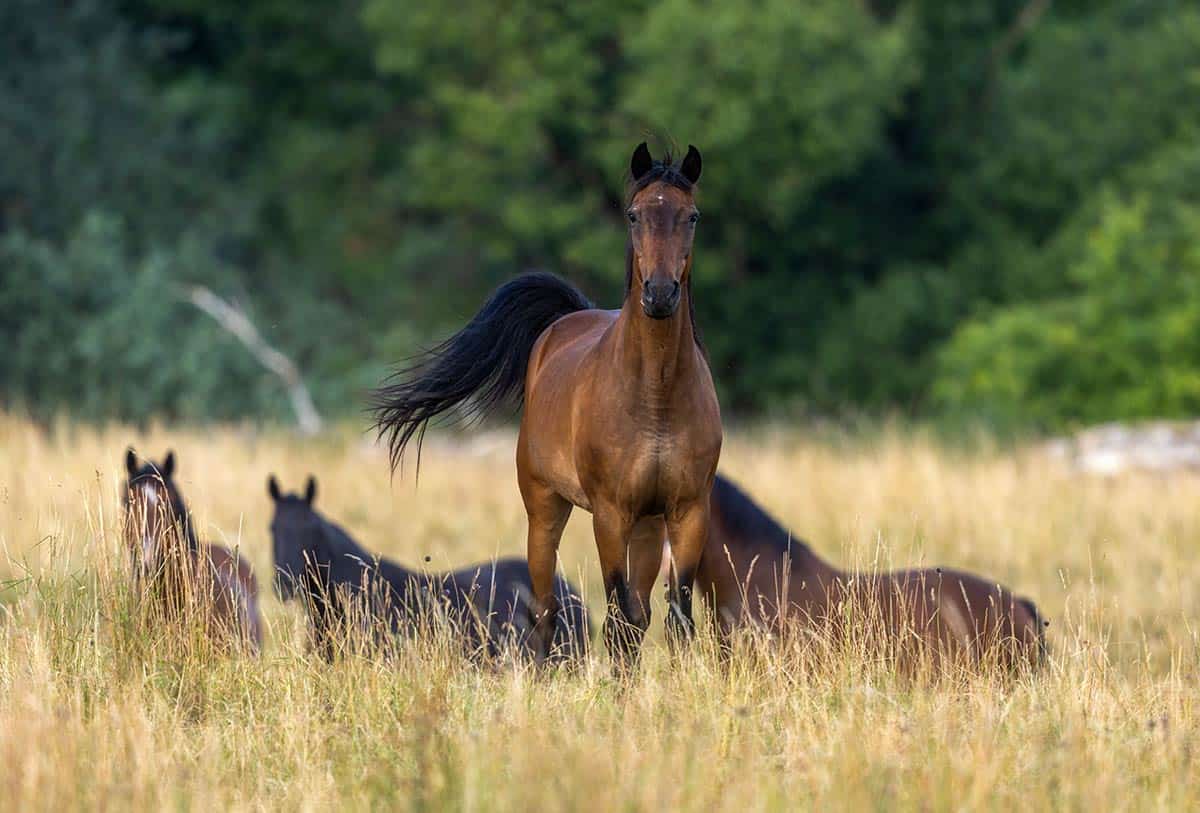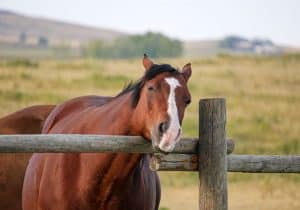How Stress Affects Your Horse

Stress in inevitable in horses’ lives, with associated changes to their health and behavior
We’ve all seen the horse that enters into a new situation, whole body on alert, each muscle taut with intense focus on his surroundings. He might poop frequently in nervous anticipation. He might swish his tail or toss his head. Other horses might vocalize repeatedly or move constantly, reluctant to stand still.
Such signs of acute stress are often transitory, with the horse settling down after investigating and accepting new environmental information. But what happens in a horse that is continually stressed? Many situations horses encounter cause them to endure chronic stress with associated changes to health and behavior, which we’ll describe in this article.
Physiological Response to Stress
First, let’s review what happens when a horse (or any animal or person) is under stress. Initially, the sympathetic nervous system activates to release catecholamines (e.g., epinephrine, norepinephrine) that are instrumental in fight-or-flight survival responses. The horse’s respiration, heart rate, and blood pressure increase, readying him for action.
“A horse’s body subconsciously or consciously readies itself for fight or flight from real or perceived threats,” says Katrina Merkies, PhD, an associate professor at the University of Guelph, in Ontario. “While heart rate increases, it is important to determine if this is from a positive or negative scenario. For example, heart rate can increase from a pleasant experience like reuniting with a beloved equine friend after a long separation or related to a negative experience such as separation from a friend.”
Therefore, she advises assessing a horse’s heart rate variability (variation in heartbeat regularity) versus heart rate alone. “A negative situation/stress experience results in a decrease in heart rate variability,” she explains. “A horse’s spontaneous eye blink rate also decreases with short-term stress. And, in both positive and negative situations, circulating hormones … increase.
“Chronic stress is stress over the long term due to changes in environment or lifestyle—this can be a continuous effect or present as a cumulative effect of short-term stress that occurs regularly or often,” Merkies adds.
If a stress response persists, the pituitary gland releases adrenocorticotropic hormone (ACTH) that stimulates release of steroid hormones called glucocorticoids, especially cortisol, from the adrenal glands. Karyn Malinowski, PhD, professor and director of Rutgers Equine Science Center, in New Brunswick, New Jersey, explains the value of this response: “In the short-term, circulating cortisol in the bloodstream increases glucose metabolism to provide energy to the horse to fuel survival responses to flee from a situation like a predator or a bad experience.”
The problem lies in the duration of cortisol release, because this hormone also affects other organ systems.
“If stress persists into a chronic condition, then the horse develops psychological and physiologic changes: Compromise of the immune system, interference with growth and reproductive performance, weight loss, and adverse gastrointestinal effects like gastric ulcer syndrome, diarrhea, colic, and changes in the intestinal lining that can lead to leaky gut syndrome,” says Malinowski. Leaky gut involves disruption of tight junctions—where two cells come together—in the intestinal lining.
Some horses exhibit stereotypies (repetitive, unvarying behaviors that appear to have no goal or function) or develop aggressive behavior in the face of chronic psychological stress and as a sequela to leaky gut syndrome. As harmful substances—pathogens, toxins, irritable proteins—leak out of the inflamed and damaged gut lining into the circulation, inflammatory protein-based cell signaling molecules called cytokines develop in response. These might cross the blood-brain barrier to elicit these behavioral changes.

Training, Competition, & Transport
Not all stress is bad, says Merkies. “Short-term stress is critical for learning and to elicit immediate responses from a horse,” she explains. “There is a certain amount of stress that enables a horse to perform at competition level, especially in venues off the farm. When stress exceeds a threshold to create a state of arousal that is detrimental to the animal, then it becomes problematic. The key is for an owner/rider to recognize obvious and subtle behavioral indicators of stress and then proactively regulate the horse’s environment to minimize or remove the stressors.”
For example, a horse that doesn’t want to be caught or moves away from the mounting block might be exhibiting what a rider perceives as a lack of cooperation, but it might, in fact, be a horse’s way of communicating about physical pain or mental stress.
In addition to decreased eye blink rate, Merkies says subtle stress behaviors include increased eyelid twitches, more frequent lip licking, and changes in ear positioning. “In fact,” she says, “these are often coping mechanisms to relieve stress, so an owner needs to recognize that a horse exhibiting such behaviors may be experiencing a stressful situation.”
In one study Malinowski compared blood cortisol concentrations in 26 show jumpers at three experience levels: inexperienced, intermediate, and elite. She took samples at rest on competition venue grounds, as the horse entered the ring, and following the jump effort. The inexperienced horses had higher cortisol concentrations than the intermediate and elite campaigners, which was somewhat expected, she says. Back home on the farm, the study horses again jumped a course of fences, and she observed an unexpected result in all three groups: Cortisol concentrations were elevated post-exercise compared to the hormone results seen at the horse show.
“During competition season, the experienced and elite horses aren’t used to much practice over fences at home, so this likely posed a novel situation that was a break from routine and therefore posed a form of physiologic stress,” Malinowski says.
Transport stress affects the horse’s immune system adversely, especially when it comes to respiratory health. Accompanying elevated cortisol levels depress the immune system, and microorganisms and airborne debris in the trailer assault the respiratory tract. Ammonia from urine and endotoxin from manure accumulating in the confined trailer space, which the horse stands in for hours at a time, further assail the airways. Horses undergoing long-term transport are at risk of reduced performance as well as more serious conditions such as shipping fever and resulting pneumonia (TheHorse.com/139404).
Social and Herd Dynamics
How horses interact with others in their group also impacts stress levels. “Horses generally interact one on one, and their hierarchy is determined by avoidance of conflict—the ‘winner’ of an interaction is the one most motivated for the disputed resource,” explains Merkies. “Thus, hierarchy positions are changeable, and the key is to provide sufficient space for individuals to be able to move away from others in the group.”
Overcrowding is one factor that affects a horse’s ability to avoid conflict. “They may end up spending energy on fighting instead of fleeing,” Merkies says. “For a horse that loses fights repeatedly, not only are there physical health consequences like wounds, but there can be impacts on access to resources like food and water. Compounded over time, these stressors will affect long-term health, particularly from cortisol-influenced depression of immune responses.”
Malinowski adds that overcrowding is often accompanied by poor nutrition and possibly internal parasite infection. “Strategies to avoid high herd densities include use of rotational grazing, monitoring the sward height of grass, and supplementation with good-quality forage,” she says.
In one study she conducted in horses kept on pasture full-time, 75-80% had gastric ulcers. Pastured horses typically experience less stress, but these findings could be partly attributable to herd dynamics and the type of exercise the study horses were asked to perform to be race fit. Even if a horse is accustomed to high-intensity exercise, that can be a stressor, she says.
For horses with no turnout, researchers on equine welfare studies have demonstrated reduced mental comfort. “Ideally, confined horses should have daily exercise and at the very least an ability to allow for nose-to-nose interactions and visibility of other horses,” says Malinowski. “This gives them a chance to vocalize, see each other, and touch where possible. This strategy can work well with a closed herd with no horses coming or going from the property, but biosecurity concerns must always be considered.”
Stereotypies
Stereotypies—weaving, stall walking, fence pacing, pawing, crib-biting, wood chewing, flank biting—might develop from boredom, which is a stressor, especially for horses housed in stalls.
“Stereotypic behavior often develops when a horse is unable to perform natural behaviors,” explains Merkies. “For example, stall walking can develop when a horse is unable to move freely in a large turnout or pasture; crib-biting or wood chewing can develop when there is limited access to forage for extended periods. Many of these behaviors develop out of frustration, yet the horse seeks to perform the natural behavior regardless of the current environment. It is likely that performance of the stereotypic behavior is actually a coping behavior to reduce stress.”
Weaning
The weaning process causes stress for both mares and foals. Malinowski describes a study in which researchers compared three groups of foals: foals not separated from their dams (the control group); weaned foals separated alone in a stall with the dam elsewhere in a field; and weaned foals in pairs of the same sex and age, with mares turned out elsewhere. Plasma cortisol increased in both groups of weaned foals for 40 hours post-weaning and in their dams for 24 hours. Cell-mediated immunity (CMI), measured by lymphocyte (white blood cell) proliferation, decreased in both the dams and the foals weaned in pairs. Malinowski says the foals weaned solo were vocal and agitated for a time when first alone but had no decrease in CMI, possibly because the physical activity of expressing their upset helped them cope with the process. In contrast, foals weaned in same-age pairs stood quietly in the corners of the stall, shaking. Malinowski says she believes the paired foals might have felt intimidated by each other, causing stress and subsequently reducing CMI through cortisol effects that decrease lymphocyte proliferation.
Causes of Chronic Stress
Chronic stress can stem from a variety of situations and management practices in horses of all ages:
- Confinement with minimal to no turnout.
- Stabling arrangements, especially if stabled near incompatible individuals.
- Herd dynamics.
- Erratic or changing feeding arrangements.
- Transport, particularly over long distances.
- Exercise, training, and competition.
- Overtraining.
- Boredom.
- Heat stress with prolonged or arduous exertions.
- Nutritional deficiencies, feed restriction, or hunger.
- Overcrowding.
- Weaning.
- Internal parasite infection.
- Poor air quality.
- Abuse and fear.
- Medical conditions such as pituitary pars intermedia dysfunction (PPID or equine Cushing’s) or insulin dysfunction.
- Illness or injury.
Equine-Assisted Therapy Work
Some 30 years ago Malinowski sampled cortisol from horses involved in a variety of disciplines ranging from polo and racing to therapeutic riding. The 30 equine-assisted therapy horses, housed in large pastures, came in to work two to three hours a day with people of all ages and disabilities. She says what she found was startling: The equine-assisted therapy horses had cortisol concentrations three to five times higher than horses in the other disciplines or groups. These findings prompted her to conduct further research on equine-assisted therapy horses.
In 2016 Malinowski and her team performed a pilot study in which they evaluated horses doing groundwork with PTSD-affected veterans for five consecutive days. They observed no changes in cortisol, heart rate variability, or well-being (based on concentrations of oxytocin, a social bonding and reproduction hormone), indicating no positive or negative impact of this work.
Researchers on other studies similarly have not identified stress markers in horses working in equine-assisted therapy programs. One evaluation (McKinney C et al., 2015) of six horses used in mounted therapeutic riding endeavors did not reveal any increase in measured cortisol or behavior changes when compared with those same horses’ responses during traditional riding efforts, such as hunt seat lessons, or at rest.
Most horses involved in equine-assisted therapy programs are known for their calm demeanors. In people, Malinowski explains that a Type C personality is one of “learned helplessness” in which the individual accepts their fate and internalizes stress as they learn to cope. Some normally calm horses might be experiencing that kind of emotional response.
Be aware that some (but not all) horses internalize stress and, while seemingly suited to a therapeutic activity, might actually be stressed in that situation. “Overt behaviors are generally easy to recognize, but it is the quiet, calm, bombproof horse that could be experiencing long-term stress or depression,” says Merkies.
Mitigation Strategies
When considering stress in horses, Malinowski says perception is a key word. She identifies three elements that affect a horse’s perception of a situation: experience, a sense of control, and attitude and personality type.
“If a horse doesn’t perceive the environment, activity, or situation to be stressful, then the horse isn’t stressed,” she says. “Each horse is an individual, and each reacts differently to similar situations. That said, horses do well with a routine and don’t always cope as well with changes to their routine.”
She recommends the following management strategies to minimize equine stress:
- Change the routine as little as possible.
- Provide ample exercise.
- House the horse outside regardless of the weather.
- Monitor social interactions within the herd.
- Keep a regular feeding schedule.
- Consider a horse’s experience in dealing with changing situations, such as a competitor that is accustomed to travel and new places compared to a more inexperienced individual.
- Know horses’ performance limits, especially if they’re older, and adjust exercise schedules accordingly.
- Provide good preventive management and herd preventive care programs to optimize health.
- Consider ways to ease travel impacts.
“Not all stress is bad,” Merkies reiterates. “We can’t live in a completely stress-free world, but we do need to be aware of what is stressful for individual horses and the level of stress with which an individual can cope.”

Written by:
Nancy S. Loving, DVM
Related Articles
Stay on top of the most recent Horse Health news with















